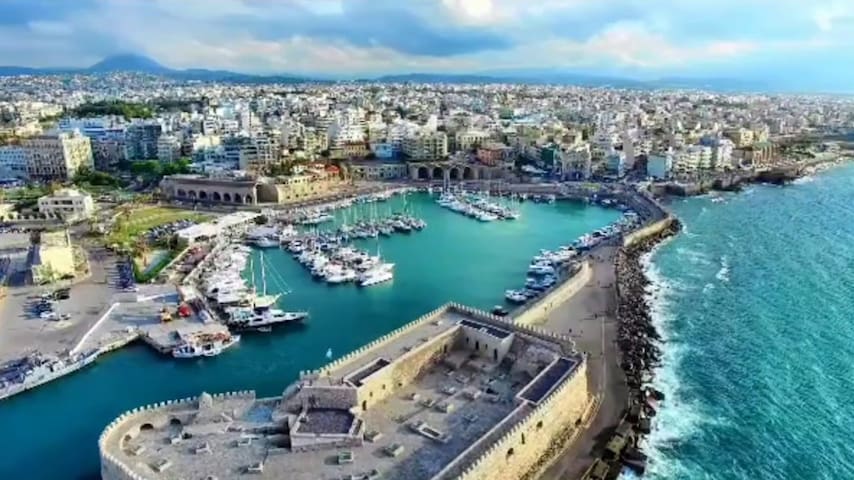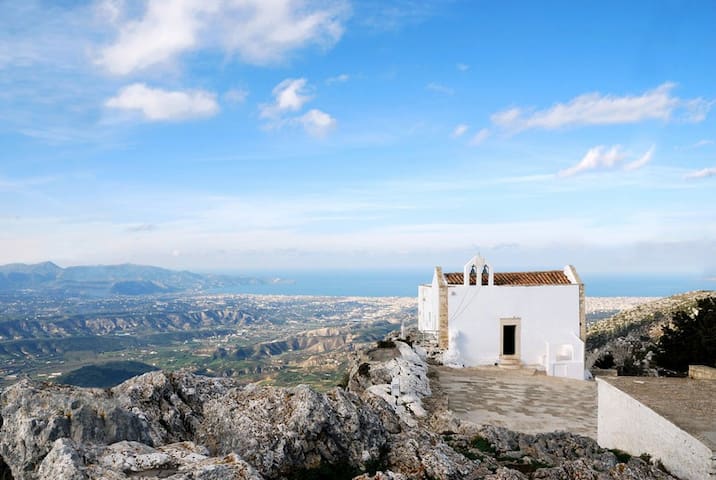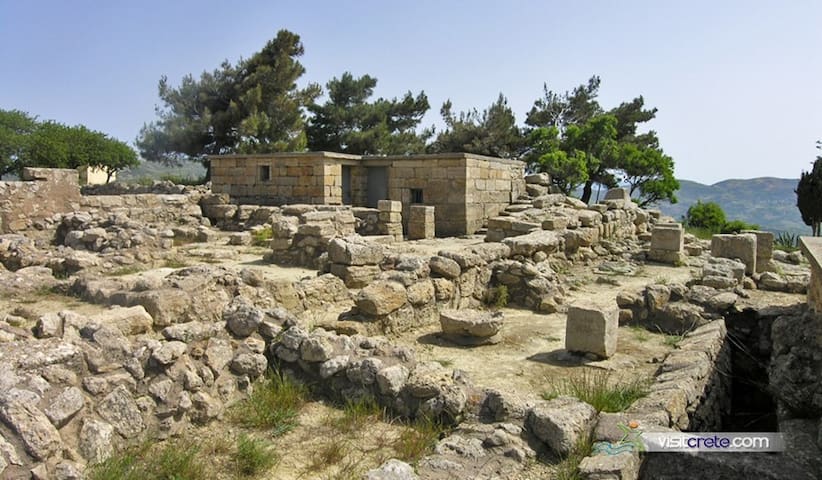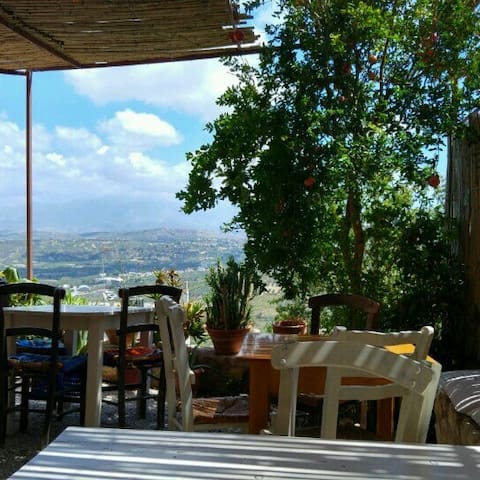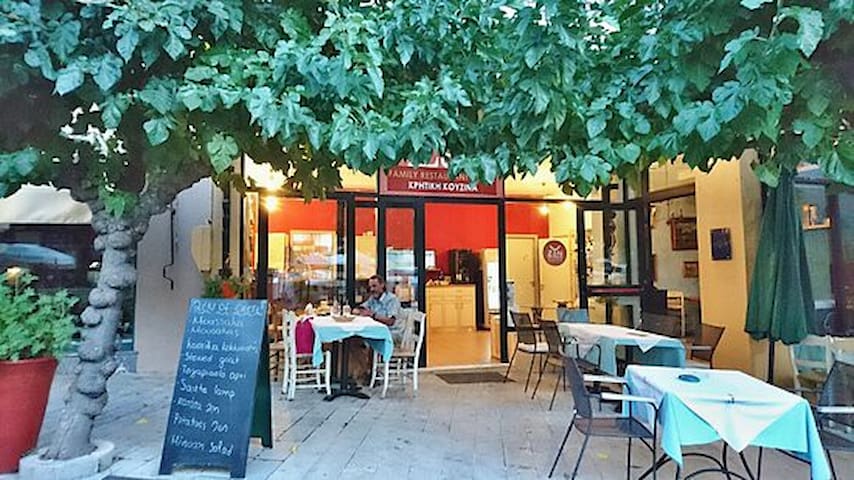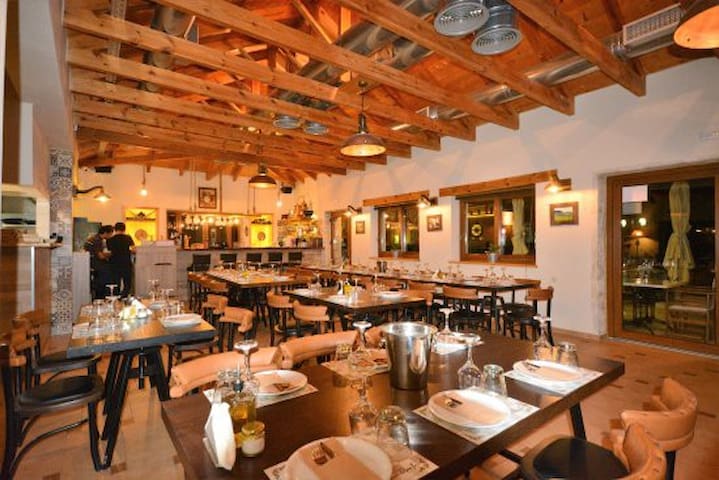City / Town
Archanes is a picturesque small town, built at an altitude of 380 meters in the middle of a basin bounded by Giouchtas range and Kefala. It is run through by Kaeratos stream, which later forms the gorge of Knossos. Archanes is 14 kilometers away from the city of Heraklion and only 7 kilometers from the Palace of Knossos. The wider area of Archanes is most significant for its numerous archaeological sites.
The colorful village has been prized by the European Union as a model for residential development. You could visit the museums of the town and discover the region's history through the findings of the Minoan and Byzantine Era and the folk art exhibits. Also many wonderful architectural buildings and Byzantine churches affirm the designation of Archanes as an ideal traditional settlement.
It is also the archaeological site of an ancient Minoan settlement in central Crete. The discovery of ancient roads leading from Archanes to Juktas, Anemospilia, Xeri Kara and Vathypetro indicate that Archanes was an important hub in the region during Minoan times. Archaeological evidence indicates that ancient Archanes spread out over the same area as the modern town of Archanes.
Visit the various restaurants and taverns at the central square to discover the world famous Cretan cuisine or the exquisite Archanes wines. Discover the methods the people of yester Crete used to produce their precious products, wine and olive oil, by visiting the traditional olive and wine presses. It is not surprising that the oldest wine press in the world has been found in Archanes. Why not participate in the summer harvesting of grapes during the celebration of the Archanes Farmer Festival and many more cultural activities.
For those of you that prefer trekking and walks in nature, there’s a lot to choose from: walk up to the sacred mountain Jiouktas, where according to ancient mythology, Zeus, the father of Gods and Humans has been buried.
Walk along E4 European trail from Profitis Ilias to Myrtia, explore the Archanes gorge under the thick shade of plane trees and sycamores and climb on the Fourni hill, where you’ll walk in a scenic pine wood and visit the ancient necropolis of Fourni
87 lokalkjente anbefaler
Archanes
Archanes is a picturesque small town, built at an altitude of 380 meters in the middle of a basin bounded by Giouchtas range and Kefala. It is run through by Kaeratos stream, which later forms the gorge of Knossos. Archanes is 14 kilometers away from the city of Heraklion and only 7 kilometers from the Palace of Knossos. The wider area of Archanes is most significant for its numerous archaeological sites.
The colorful village has been prized by the European Union as a model for residential development. You could visit the museums of the town and discover the region's history through the findings of the Minoan and Byzantine Era and the folk art exhibits. Also many wonderful architectural buildings and Byzantine churches affirm the designation of Archanes as an ideal traditional settlement.
It is also the archaeological site of an ancient Minoan settlement in central Crete. The discovery of ancient roads leading from Archanes to Juktas, Anemospilia, Xeri Kara and Vathypetro indicate that Archanes was an important hub in the region during Minoan times. Archaeological evidence indicates that ancient Archanes spread out over the same area as the modern town of Archanes.
Visit the various restaurants and taverns at the central square to discover the world famous Cretan cuisine or the exquisite Archanes wines. Discover the methods the people of yester Crete used to produce their precious products, wine and olive oil, by visiting the traditional olive and wine presses. It is not surprising that the oldest wine press in the world has been found in Archanes. Why not participate in the summer harvesting of grapes during the celebration of the Archanes Farmer Festival and many more cultural activities.
For those of you that prefer trekking and walks in nature, there’s a lot to choose from: walk up to the sacred mountain Jiouktas, where according to ancient mythology, Zeus, the father of Gods and Humans has been buried.
Walk along E4 European trail from Profitis Ilias to Myrtia, explore the Archanes gorge under the thick shade of plane trees and sycamores and climb on the Fourni hill, where you’ll walk in a scenic pine wood and visit the ancient necropolis of Fourni
Heraklion is the largest city in Crete and the fifth largest city in Greece with a population of about 200.000. Heraklion houses the public services and the major scientific centers of Crete, being the commercial center of the island with the main port and airport. The ancient name Ηράκλειον was revived in the 19th century and comes from the nearby Roman port of Heracleum ("Hercules's city"), whose exact location is unknown.
The city has a great history and, although its character has altered tremendously due to the catastrophic interventions of the past century, there are places that remind something of the beautiful Grand Castle of the Mediterranean. Even today the visitor can get a good taste of the glorious image of the past, while the locals can be surprised by the unknown corners of Heraklion and the story hidden behind them.
Heraklion is close to the ruins of the palace of Knossos, also known as the Palace of Minos which in Minoan times was the largest center of population on Crete. Knossos had a port at the site of Heraklion from the beginning of Early Minoan period (3500 to 2100 BC). Between 1600 and 1525 BC, the port was destroyed by a volcanic tsunami from nearby Santorini, leveling the region and covering it with ash. It is located 5.5 km southeast of the city.
132 lokalkjente anbefaler
Heraklion
Heraklion is the largest city in Crete and the fifth largest city in Greece with a population of about 200.000. Heraklion houses the public services and the major scientific centers of Crete, being the commercial center of the island with the main port and airport. The ancient name Ηράκλειον was revived in the 19th century and comes from the nearby Roman port of Heracleum ("Hercules's city"), whose exact location is unknown.
The city has a great history and, although its character has altered tremendously due to the catastrophic interventions of the past century, there are places that remind something of the beautiful Grand Castle of the Mediterranean. Even today the visitor can get a good taste of the glorious image of the past, while the locals can be surprised by the unknown corners of Heraklion and the story hidden behind them.
Heraklion is close to the ruins of the palace of Knossos, also known as the Palace of Minos which in Minoan times was the largest center of population on Crete. Knossos had a port at the site of Heraklion from the beginning of Early Minoan period (3500 to 2100 BC). Between 1600 and 1525 BC, the port was destroyed by a volcanic tsunami from nearby Santorini, leveling the region and covering it with ash. It is located 5.5 km southeast of the city.
Αξιοθέατα
The centre of Minoan civilisation and capital of Minoan Crete lay 5km south of Heraklion.
Knossos flourished for approximately two thousand years. It had large palace buildings, extensive workshop installations and luxurious rock-cut cave and tholos tombs. As a major centre of trade and the economy, Knossos maintained ties with the majority of cities in the Eastern Mediterranean.
Wealth accumulation and the advancement of an urban lifestyle were the hallmarks of this zenith, which began circa 2000 BC and was typified by magnificent monumental buildings and a complex social structure.
The Minoan palace is the main site of interest at Knossos, an important city in antiquity, which was inhabited continuously from the Neolithic period until the 5th c. AD. The palace was built on the Kephala hill and had easy access to the sea and the Cretan interior. According to tradition, it was the seat of the wise king Minos. The Palace of Knossos is connected with thrilling legends, such as the myth of the Labyrinth, with the Minotaur, and the story of Daidalos and Ikaros.
227 lokalkjente anbefaler
Minoan Palace of Knossos
8 ΦειδίουThe centre of Minoan civilisation and capital of Minoan Crete lay 5km south of Heraklion.
Knossos flourished for approximately two thousand years. It had large palace buildings, extensive workshop installations and luxurious rock-cut cave and tholos tombs. As a major centre of trade and the economy, Knossos maintained ties with the majority of cities in the Eastern Mediterranean.
Wealth accumulation and the advancement of an urban lifestyle were the hallmarks of this zenith, which began circa 2000 BC and was typified by magnificent monumental buildings and a complex social structure.
The Minoan palace is the main site of interest at Knossos, an important city in antiquity, which was inhabited continuously from the Neolithic period until the 5th c. AD. The palace was built on the Kephala hill and had easy access to the sea and the Cretan interior. According to tradition, it was the seat of the wise king Minos. The Palace of Knossos is connected with thrilling legends, such as the myth of the Labyrinth, with the Minotaur, and the story of Daidalos and Ikaros.
Jiouchtas in ancient times was considered a sacred mountain, mainly because it resembles a human face that looks to the sky from the northwest. Even today the human face- like mountain causes interest for its anthropomorphic shape. According to the legend, this is the face of the Greek Zeus and the mountain is his tomb. Indeed the name Jiouchtas is a corruption of the Latin word for Zeus, Jupiter.
The mountain was very important for the Minoans since it was the first mountain they saw while their ships approached the shores of Crete. Here they built at least two Minoan sanctuaries, the one at the highest point of the mountain (Psili Korfi) and the second at the position Anemospilia.
The sanctuary of the Giouchtas peak is the most important and largest peak sanctuary in Crete and was directly dependent on Knossos with covered and open spaces for accommodation, storage and rituals. .
The Psili Korfi peak hosted an 8mx5m worship building with a precinct surrounded by a cyclopean wall, in the sanctuary of which the archaeologists have revealed many idols of men, women, animals, body parts, offering tables, inscriptions on Linear A script, bronze and silver pendants, bronze axes and golden items. The natural trench of the sanctuary on the rock of the mountain, where many of the archeological findings were found, was used for putting the devotees of the worshippers.
Ψηλή Κορφή
Jiouchtas in ancient times was considered a sacred mountain, mainly because it resembles a human face that looks to the sky from the northwest. Even today the human face- like mountain causes interest for its anthropomorphic shape. According to the legend, this is the face of the Greek Zeus and the mountain is his tomb. Indeed the name Jiouchtas is a corruption of the Latin word for Zeus, Jupiter.
The mountain was very important for the Minoans since it was the first mountain they saw while their ships approached the shores of Crete. Here they built at least two Minoan sanctuaries, the one at the highest point of the mountain (Psili Korfi) and the second at the position Anemospilia.
The sanctuary of the Giouchtas peak is the most important and largest peak sanctuary in Crete and was directly dependent on Knossos with covered and open spaces for accommodation, storage and rituals. .
The Psili Korfi peak hosted an 8mx5m worship building with a precinct surrounded by a cyclopean wall, in the sanctuary of which the archaeologists have revealed many idols of men, women, animals, body parts, offering tables, inscriptions on Linear A script, bronze and silver pendants, bronze axes and golden items. The natural trench of the sanctuary on the rock of the mountain, where many of the archeological findings were found, was used for putting the devotees of the worshippers.
Fourni is a small lush hill green next to the picturesque Arhanes village, about 12km south of Heraklion, bounded to the west by the Gorge of Archanes and to the west by the valley of Archanes. It is known for the preminoan cemetery of Fourni at its south part, one of the largest of its era in South Aegean. Fourni can be accessed mainly through the village Kato Arhanes, where you’ll meet signs leading there, but also through hiking trails from Epano Archanes and the aqueduct of Morozini in Karydaki.
6 lokalkjente anbefaler
forest Fourni
Fourni is a small lush hill green next to the picturesque Arhanes village, about 12km south of Heraklion, bounded to the west by the Gorge of Archanes and to the west by the valley of Archanes. It is known for the preminoan cemetery of Fourni at its south part, one of the largest of its era in South Aegean. Fourni can be accessed mainly through the village Kato Arhanes, where you’ll meet signs leading there, but also through hiking trails from Epano Archanes and the aqueduct of Morozini in Karydaki.
A museum delineating the history of the island Crete, complete with artifacts belonging to the ancient civilizations that once populated the island
474 lokalkjente anbefaler
Heraklion arkeologiske museum
1 ChatzidakiA museum delineating the history of the island Crete, complete with artifacts belonging to the ancient civilizations that once populated the island
The Archaeological Museum of Archanes is in a beautiful neoclassical building with 570 square meters area, in Tzami, in the center of the Archanes town.
The small but nice building of the Museum, a neoclassical building of the previous century, was the first Primary School of the town that worked until the 1920s.
Some findings, especially ceramics, found in the Fourni Minoan cemetery, the temple of the sacrifices of people and the mansion in Tourkogeitonia, are in the museum.
8 lokalkjente anbefaler
Archaeological Museum
101 LamprakiThe Archaeological Museum of Archanes is in a beautiful neoclassical building with 570 square meters area, in Tzami, in the center of the Archanes town.
The small but nice building of the Museum, a neoclassical building of the previous century, was the first Primary School of the town that worked until the 1920s.
Some findings, especially ceramics, found in the Fourni Minoan cemetery, the temple of the sacrifices of people and the mansion in Tourkogeitonia, are in the museum.
The palace of Archanes is located in the suburb Tourkogitonia of Epano Archanes town. It came to light only in 1964 by the famous Cretan archaeologist Giannis Sakellarakis because, by then, only a few traces of the palace had been found. Some parts of the palace are still below the houses of modern Arhanes. The palace was equally rich and powerful with the palace of Knossos and seems to have had strong relations of dependence. The purpose of the palace and the Minoan town of Archanes, which occupied as much land as the modern town, was to control the rich and fertile mainland and to coordinate the many religious centers of the region (Anemospilia sanctuary, Giouchtas mount, necropolis in Fourni).
Tourkogitonia Minoan Palace
The palace of Archanes is located in the suburb Tourkogitonia of Epano Archanes town. It came to light only in 1964 by the famous Cretan archaeologist Giannis Sakellarakis because, by then, only a few traces of the palace had been found. Some parts of the palace are still below the houses of modern Arhanes. The palace was equally rich and powerful with the palace of Knossos and seems to have had strong relations of dependence. The purpose of the palace and the Minoan town of Archanes, which occupied as much land as the modern town, was to control the rich and fertile mainland and to coordinate the many religious centers of the region (Anemospilia sanctuary, Giouchtas mount, necropolis in Fourni).
Vathipetro is a very small settlement located 4km and 20km south of Archanes and Heraklion, respectively, in a location with spectacular views to the south side of Jiouchtas Mount and the dam of Chalavrianos. At position Piso Livadia, next to the village and the road connecting Archanes to Houdetsi, a Minoan mansion was revealed in 1949 by Spiros Marinatos. The excavations were completed in 1956, but restoration took place also in 1973. One of the restored rooms hosts a small exhibition with findings from the site.
This small palace was built in 1600 BC but was destroyed in 1550 BC to get restored partially in 1450 BC. It had two floors, a central courtyard and was used as a luxury country house for a Minoan officer. The place housed an olive press, a wine press, a warehouse with 16 jars, a pottery workshop and a beautiful jar for carrying olive oil.
Αρχαιολογικός Χώρος Βαθύπετρο
Vathipetro is a very small settlement located 4km and 20km south of Archanes and Heraklion, respectively, in a location with spectacular views to the south side of Jiouchtas Mount and the dam of Chalavrianos. At position Piso Livadia, next to the village and the road connecting Archanes to Houdetsi, a Minoan mansion was revealed in 1949 by Spiros Marinatos. The excavations were completed in 1956, but restoration took place also in 1973. One of the restored rooms hosts a small exhibition with findings from the site.
This small palace was built in 1600 BC but was destroyed in 1550 BC to get restored partially in 1450 BC. It had two floors, a central courtyard and was used as a luxury country house for a Minoan officer. The place housed an olive press, a wine press, a warehouse with 16 jars, a pottery workshop and a beautiful jar for carrying olive oil.
Food & Beverage
CUISINES
Mediterranean, Greek, European
SPECIAL DIETS
Vegan Options, Vegetarian Friendly
Η αυλή της Χρυσάνθης
31 ΠαλαιόχωραςCUISINES
Mediterranean, Greek, European
SPECIAL DIETS
Vegan Options, Vegetarian Friendly
CUISINES
Mediterranean, Greek, Grill, Healthy
SPECIAL DIETS
Vegetarian Friendly, Vegan Options, Gluten Free Options
Zen of Crete • Greek Cuisine • Wine Beer Coffee
2 Platia Eleftheriou VenizelouCUISINES
Mediterranean, Greek, Grill, Healthy
SPECIAL DIETS
Vegetarian Friendly, Vegan Options, Gluten Free Options
CUISINES
Greek, Mediterranean
SPECIAL DIETS
Vegan Options, Vegetarian Friendly
Τριορούκουνο Trioroukouno
133 Eparchiaki Odos Patsidon - VathipetrouCUISINES
Greek, Mediterranean
SPECIAL DIETS
Vegan Options, Vegetarian Friendly
Zelita Winebar
CUISINES
Greek
FEATURES
Table Service, Reservations


